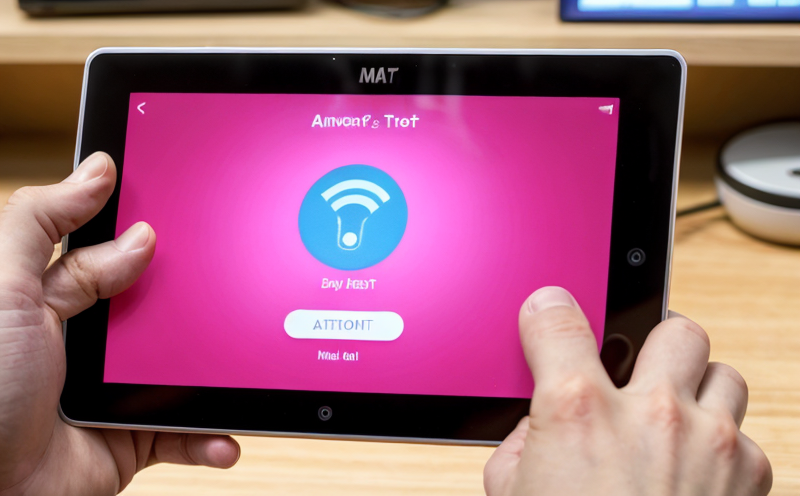Voice Command Recognition Testing
As the world transitions towards smart and connected consumer devices, voice command recognition has become an essential feature. This testing ensures that devices accurately recognize spoken commands regardless of accents, background noise, or environmental conditions. Voice Command Recognition Testing is critical for product safety, user satisfaction, and compliance with international standards.
In this service, we test the accuracy, reliability, and robustness of voice command systems in consumer products such as smart speakers, wearable devices, and home automation systems. Our testing covers various parameters including speech clarity, noise tolerance, latency times, and error rates under different environmental conditions.
Our team utilizes state-of-the-art equipment to simulate real-world scenarios that a device might encounter. This includes varying room sizes, multiple speakers in the same space, and diverse accents and dialects from around the world. We also test for compatibility with different voice recognition software and APIs to ensure seamless integration.
The testing process begins with thorough preparation of each specimen. This involves setting up controlled environments that replicate typical user interactions. For example, we use dummy speakers or microphones in various settings to simulate a user’s experience. Once the setup is complete, we run multiple iterations of commands to ensure consistent results.
Using our sophisticated instruments and software tools, we analyze the performance metrics of each device. Key parameters include signal-to-noise ratio (SNR), intelligibility scores, and error rates. These metrics provide a comprehensive view of how well the voice command system performs under different conditions. Our team also evaluates user feedback to ensure that the device meets the highest standards for customer satisfaction.
Compliance with international standards is crucial in this field. We adhere strictly to ISO/IEC 29112-3:2020, which provides guidelines on voice activity detection and speech recognition accuracy. Our testing ensures that products meet these stringent requirements, thereby minimizing the risk of recalls or legal issues.
- Speech Clarity: Ensuring clear pronunciation and comprehension across various accents.
- Noise Tolerance: Evaluating how well a device performs in noisy environments.
- Error Rates: Measuring the frequency of incorrect command recognition.
- Latency Times: Assessing the time it takes for a device to process and respond to a command.
In addition to these technical aspects, we also consider user experience factors. This includes ease of use, intuitiveness, and overall satisfaction with the voice command system. By focusing on both technical accuracy and user experience, our testing provides a holistic evaluation that helps manufacturers improve their products.
Why Choose This Test
Selecting Voice Command Recognition Testing is essential for several reasons. Firstly, it ensures that your product meets the highest standards of quality and reliability. In today’s competitive market, consumers expect not only functionality but also seamless integration into their daily lives.
Secondly, this testing helps you stay ahead of regulatory requirements. Many countries have strict regulations regarding voice command systems, particularly in consumer products. By conducting thorough tests early in the development process, you can avoid costly delays and fines later on.
Thirdly, it enhances user trust and satisfaction. A reliable and responsive voice command system improves customer experience and loyalty. This is especially important for smart home devices where ease of use is paramount.
Lastly, our testing provides valuable insights into potential improvements. Through detailed analysis, we can identify areas where your product could be enhanced or optimized. This data-driven approach ensures continuous improvement and innovation in your products.
Quality and Reliability Assurance
At [Laboratory Name], ensuring the quality and reliability of consumer products is our top priority. Voice Command Recognition Testing plays a crucial role in this process by providing comprehensive assessments that cover all aspects of voice command systems.
We employ rigorous testing protocols to ensure consistent performance across different models and generations. Our team uses advanced software tools and real-world simulation environments to test devices under various conditions. This includes varying levels of background noise, different types of accents, and diverse environmental factors.
Our testing process is designed to identify potential issues early in the development cycle, allowing manufacturers to make necessary adjustments before product launch. By doing so, we help reduce costs associated with late-stage corrections and improve overall product quality.
We also provide detailed reports that outline all test results along with recommendations for improvement. These reports are invaluable tools for R&D teams looking to refine their designs or expand feature sets based on real-world performance data. Additionally, they serve as important resources during regulatory submissions and audits.
Competitive Advantage and Market Impact
- Innovation Leadership: By staying at the forefront of voice command technology through rigorous testing, manufacturers can differentiate themselves from competitors. This innovation leadership translates into higher market share and customer loyalty.
- Consumer Trust: Reliable products build trust with consumers, leading to increased brand reputation and sales.
- Regulatory Compliance: Meeting or exceeding international standards demonstrates a commitment to safety and quality, which can influence regulatory decisions positively.
- Pricing Strategy: Competitive testing ensures that products are priced appropriately based on their quality, making them more attractive to price-sensitive consumers while maintaining profitability for manufacturers.
In conclusion, Voice Command Recognition Testing is not just a technical requirement; it is a strategic imperative. It helps ensure product excellence, fosters innovation, builds consumer trust, and supports regulatory compliance—all of which contribute significantly to a company’s competitive edge in the global market.





